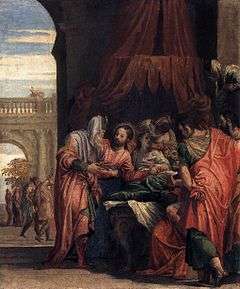Raising of Jairus' daughter
The episode of the daughter of Jairus is a combination of miracles of Jesus in the Gospels (Mark 5:21–43, Matthew 9:18–26 and Luke 8:40–56)

Context
The story immediately follows the exorcism at Gerasa. Jairus (Greek: Ἰάειρος, Iaeiros, from the Hebrew name Yair), a patron or ruler of a Galilee synagogue, had asked Jesus to heal his 12-year-old daughter.
As they were traveling to Jairus' house, a sick woman in the crowd touched Jesus' cloak and was healed of her sickness. Jesus turned round to the woman and said "Daughter, your faith has made you well. Go in peace." (see Luke 8:43-48) (Christ healing the bleeding woman). In Mark's and Luke's version, a messenger arrived with the news that Jairus' daughter had died, and he was advised not to trouble Jesus any further. However, Jesus responded:
Be not afraid, only believe.
Event
Jesus continued to the house, where Jesus "saw a commotion, people weeping and wailing loudly" (Mark 5:38). He informed all those present that the girl was not dead but asleep. He then went upstairs and restored the little girl to life. In Mark's account, the Aramaic phrase "Talitha kum" (transliterated into Greek as ταλιθα κουμ and meaning, "Little girl, I say to you, get up!") is attributed to Jesus.
The combined stories have been used as an example of intercalation, where one incident is inserted within another, linked in this case by the connection between the 12-year ailment and the 12-year-old girl.[1][2]
Interpretations
John Donahue and Daniel Harrington state that this episode shows that "faith, especially as embodied by the bleeding woman, can exist in seemingly hopeless situations".[3]
Michael Keene states that there is a link between Jairus and the woman: "The link between them is faith since both Jairus and the bleeding woman showed great faith in Jesus".[4]
John Walvoord and Roy Zuck state that: "What appeared to be a disastrous delay in the healing of the woman actually assured the restoration of Jairus' daughter. It was providentially ordered to test and strengthen Jairus' faith."[5] Johann Lange also states that: "This delay would serve both to try and to strengthen the faith of Jairus."[6]
See also
| Wikimedia Commons has media related to Raising of Jairus' daughter. |
References
Citations
- "Intercalations in the synoptic tradition". www.textexcavation.com.
- James R. Edwards, “Markan Sandwiches: The Significance of Interpolations in Markan Narratives,” Novum Testamentum 31 no. 3 (1989): 193-216; Tom Shepherd, “The Narrative Function of Markan Intercalation,” New Testament Studies 41 (1995): 522-40; James L. Resseguie, "A Glossary of New Testament Narrative Criticism with Illustrations," in Religions, 10 (3: 217), 28.
- Donahue & Harrington 2005, p. 182.
- Keene 2002, p. 72.
- Walvoord & Zuck 1983, p. 124.
- Lange 1960, p. 174.
Sources
- Donahue, John R.; Harrington, Daniel J. (2005). The Gospel of Mark. ISBN 0-8146-5965-9.CS1 maint: ref=harv (link)
- Keene, Michael (2002). St Mark's Gospel and the Christian faith. ISBN 0-7487-6775-4.CS1 maint: ref=harv (link)
- Lange, Johann Peter (1960). A commentary on the Holy Scriptures. Zondervan. ASIN B00133NOEM.CS1 maint: ref=harv (link)
- Walvoord, John F.; Zuck, Roy B. (1983). The Bible Knowledge Commentary. ISBN 0-88207-812-7.CS1 maint: ref=harv (link)
Raising of Jairus' daughter Life of Jesus: Miracles | ||
| Preceded by Healing the Gerasene Demonic Miracles of Jesus |
New Testament Events |
Succeeded by Rejection of Jesus Ministry of Jesus |
